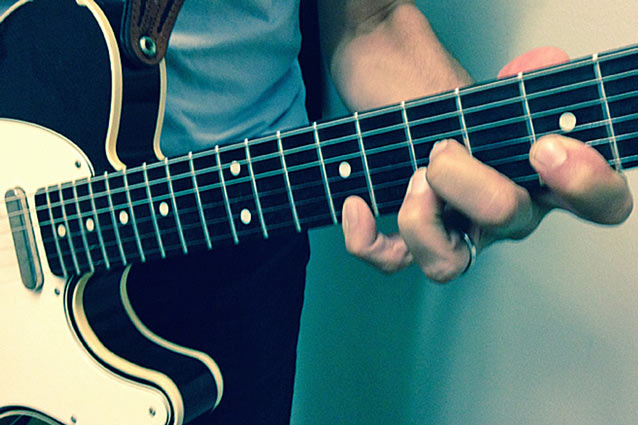Extreme String Skipping and String-Skipping Tapping for the Fast and the Accurate

Even within complex solos, most guitarists play several notes on one string, and then move up or down to the next string. This creates melodically linear patterns.
But more importantly, it’s the path of least resistance. It’s comparatively easy to go from one string to an adjacent string. Easy as compared to what, you ask? To skipping the adjacent string (or strings) to hit your next note, more commonly referred to as “string skipping.”
So why string skipping? Because it allows you greater range and dynamics. When you skip strings, you can suddenly play wider intervals than you hear in common guitar solos. There are a few famous guitar players who have employed this style, including Paul Gilbert, Eric Johnson and even Slash on his intro to Guns N' Roses' “Sweet Child O’ Mine.”
But more often than not, even good guitar players shy away from this technique. It’s not that easy. Imagine you’re playing a blues progression in E. You’ve just hit that high E (12th fret) on the high E (first) string and stretched it long enough to make the sky cry. But now it’s time to play an A note, and you want to go low instead of high.
OPTION 1: Stay on that E string and slide down to the fifth fret.
OPTION 2: Hit the (same) A on the 10th fret of the B string (one string down).
These are both pretty standard options, and you can hear them in the solos of innumerable blues songs. But what if you want a wider leap? What if instead of going to the predictable A note that's closest to the E, you want a much lower A note, the one that’s a full octave below what the listener expects to hear? That’s where string skipping comes in.
From the 12th fret of the high E string, you would drop to the 12th fret of the A (fifth) string. That’s a three-string vault for your fingers, but since you’re staying on the same fret, it shouldn’t be too difficult. But what if you wanted to get really dynamic, and go from that high E down to the lowest A you’ve got? And what if—just to make things more interesting—hitting the open A wasn’t an option because you just busted a hammer-on/pull-off pattern on the high E and now want to repeat it with your pinky starting on the low A?
This is where extreme string skipping comes in, and it’s going to take all your speed and attention to detail to pull it off.
Because while dropping from that high E across four strings is hard, moving your hand all the way down the neck at the same time to land on the fifth fret (A note) of the low E string is downright impressive. Extreme string skips of this nature require your fingers and hands to move in vertical (skipping strings) and horizontal (wide leaps on the neck) patterns at the same time.
Being able to play back and forth both quickly and accurately in different octaves is a challenge. Picture someone playing piano with only one hand and going from a pattern starting on high E down three octaves and back again. That’s a lot of keys! String skipping on the guitar is no different—you’ve got a lot of ground to cover and you’re going to have to do it quickly and accurately.
Want to make it even more challenging/shred-tacular? Add tapping to the mix. Most tapping patterns—even more so than standard solos—stay on one string, or at least follow a linear progression like tapping on the first string, tapping the second string, tapping the third, etc. How often do you hear a guitarist tap the first string then leap to tap the fifth? Me neither.
But that doesn’t mean we shouldn’t do it.
Tell me tapped lightning fast shifts between octaves don’t melt faces and I’ll quit guitar and take up baccarat. I use extreme string skipping in the solo for Stone Mob’s “Requiem.” At the start of the solo, I bounce back and forth between hammer-on/pull-off patterns from the high A (17th fret) on the high E (first) string to the A (fifth fret) on the low E (sixth string) and back again. That’s a four string-four octave jump—about as extreme a string skip as you can make on a guitar.
Later in the solo I skip two strings and three octaves to tap a back and forth pattern on the first and fourth strings. Watch the video for “Requiem” (top), then watch the instructional video; I’ll show you how to vault strings—even while tapping.
Warning: These techniques are not for the faint of heart. But sometimes it takes a leap of faith—and fingers—to do something awesome. Cheers and keep those fingers jumping!
Get The Pick Newsletter
All the latest guitar news, interviews, lessons, reviews, deals and more, direct to your inbox!
“There are so many sounds to be discovered when you get away from using a pick”: Jared James Nichols shows you how to add “snap, crackle and pop” to your playing with banjo rolls and string snaps
Don't let chord inversions bamboozle you. It's simply the case of shuffling the notes around







![Joe Bonamassa [left] wears a deep blue suit and polka-dotted shirt and plays his green refin Strat; the late Irish blues legend Rory Gallagher [right] screams and inflicts some punishment on his heavily worn number one Stratocaster.](https://cdn.mos.cms.futurecdn.net/cw28h7UBcTVfTLs7p7eiLe.jpg)


